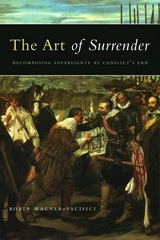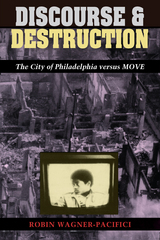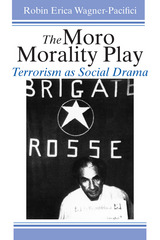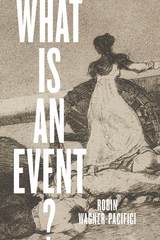4 books about Wagner-Pacifici, Robin

The Art of Surrender
Decomposing Sovereignty at Conflict's End
Robin Wagner-Pacifici
University of Chicago Press, 2005
How do we know when a war ends? For many, the resolution of a conflict comes not with the last traces of smoke left on the battlefield, but with the formal ceremonies of surrender: possession and repossession, the signing of treaties, and the pomp and circumstance that mark them. Historically, most conflicts have ended with such rituals. But, as Robin Wagner-Pacifici reveals in The Art of Surrender, they should not be seen as merely a matter of giving up. They also offer ways of holding back and signal early fault lines that give rise to later undoings and conflicts.
The Art of Surrender explores these ritual concessions as acts of warfare, performances of submission, demonstrations of power, and representations of shifting, unstable worlds. Wagner-Pacifici analyzes three significant military surrenders in the history of warfare—the Thirty Years' War of the seventeenth century, the American Civil War, and World War II—through the use of period documents and forms, maps, literature, witness accounts, photographs, and paintings that were left as proof of victory and defeat. In her analyses of such archival material and iconic works of art, she considers the limits of sovereignty at conflict's end, showing how the ways we concede loss can be as important as the ways we claim victory.
The Art of Surrender explores these ritual concessions as acts of warfare, performances of submission, demonstrations of power, and representations of shifting, unstable worlds. Wagner-Pacifici analyzes three significant military surrenders in the history of warfare—the Thirty Years' War of the seventeenth century, the American Civil War, and World War II—through the use of period documents and forms, maps, literature, witness accounts, photographs, and paintings that were left as proof of victory and defeat. In her analyses of such archival material and iconic works of art, she considers the limits of sovereignty at conflict's end, showing how the ways we concede loss can be as important as the ways we claim victory.
[more]

Discourse and Destruction
The City of Philadelphia versus MOVE
Robin Wagner-Pacifici
University of Chicago Press, 1993
In the early 1980s the radical group MOVE settled into a rowhouse in a predominantly African-American neighborhood of west Philadelphia, beginning years of confrontations with neighbors and police over its anti-establishment ways and militant stance against all social and political institutions. On May 13, 1985, following a period of increased MOVE activity and threats by neighbors to take matters into their own hands, the city moved from bureaucratic involvement to violent intervention. Police bullhorned arrest warrants, hosed down the rowhouse, sprayed tear gas through its walls, and dropped explosives from a helicopter. By the end of the day, eleven MOVE members were dead, an entire block of the neighborhood was destroyed, and Mayor Wilson Goode was calling for an investigation.
How did this struggle between the city and MOVE go from memos and meetings to tear gas and bombs? And how does the mandate to defend public order become a destructive force? Sifting through the hearings that followed the deadly encounter, Robin Wagner-Pacifici reconstructs the conflict between MOVE and the city of Philadelphia. Against this richly nuanced account, in which the participants—from the mayor and the police officers to members of MOVE and their neighbors—offer opposing versions of their aims, assumptions, and strategies, Wagner-Pacifici develops a compelling analysis of the relation between definition and action, between language and violence.
Was MOVE simply a radical, black separatist group with an alternative way of life? Or was it a terrorist cult that held a neighborhood and politicians hostage to its offensive language and bizarre behavior? Wagner-Pacifici shows how competing definitions of MOVE led to different strategies for managing the conflict. In light of the shockingly similar, and even more deadly, 1993 Branch Davidian disaster in Waco, Texas, such an analysis becomes imperative. Indeed, for those who hope to understand—and, finally, to forestall—the moment when language and violence are inexorably drawn together, this book demands attention.
How did this struggle between the city and MOVE go from memos and meetings to tear gas and bombs? And how does the mandate to defend public order become a destructive force? Sifting through the hearings that followed the deadly encounter, Robin Wagner-Pacifici reconstructs the conflict between MOVE and the city of Philadelphia. Against this richly nuanced account, in which the participants—from the mayor and the police officers to members of MOVE and their neighbors—offer opposing versions of their aims, assumptions, and strategies, Wagner-Pacifici develops a compelling analysis of the relation between definition and action, between language and violence.
Was MOVE simply a radical, black separatist group with an alternative way of life? Or was it a terrorist cult that held a neighborhood and politicians hostage to its offensive language and bizarre behavior? Wagner-Pacifici shows how competing definitions of MOVE led to different strategies for managing the conflict. In light of the shockingly similar, and even more deadly, 1993 Branch Davidian disaster in Waco, Texas, such an analysis becomes imperative. Indeed, for those who hope to understand—and, finally, to forestall—the moment when language and violence are inexorably drawn together, this book demands attention.
[more]

The Moro Morality Play
Terrorism as Social Drama
Robin Wagner-Pacifici
University of Chicago Press, 1986
On March 16, 1978, the former prime minister of Italy, Aldo Moro, was kidnapped by the Red Brigades, and what followed—the fifty-five days of captivity that resulted in Moro's murder—constitutes one of the most striking social dramas of the twentieth century. In this compelling study of terrorism, Robin Wagner-Pacifici employs methods from sociology, symbolic anthropology, and literary criticism to decode the many social "texts" that shaped the event: political speeches, newspaper reports, television and radio news, editorials, photographs, Moro's letters, Red Brigade communiques, and appeals by various international figures. The analysis of these "texts" calls into question the function of politics, social drama, spectacle, and theater. Wagner-Pacifici provides a dramaturgic analysis of the Moro affair as a method for discussing the culture of politics in Italy.
[more]

What Is an Event?
Robin Wagner-Pacifici
University of Chicago Press, 2017
We live in a world of breaking news, where at almost any moment our everyday routine can be interrupted by a faraway event. Events are central to the way that individuals and societies experience life. Even life’s inevitable moments—birth, death, love, and war—are almost always a surprise. Inspired by the cataclysmic events of September 11, Robin Wagner-Pacifici presents here a tour de force, an analysis of how events erupt and take off from the ground of ongoing, everyday life, and how they then move across time and landscape.
What Is an Event? ranges across several disciplines, systematically analyzing the ways that events emerge, take shape, gain momentum, flow, and even get bogged down. As an exploration of how events are constructed out of ruptures, it provides a mechanism for understanding eventful forms and flows, from the micro-level of individual life events to the macro-level of historical revolutions, contemporary terrorist attacks, and financial crises. Wagner-Pacifici takes a close look at a number of cases, both real and imagined, through the reports, personal narratives, paintings, iconic images, political posters, sculptures, and novels they generate and through which they live on. What is ultimately at stake for individuals and societies in events, Wagner-Pacifici argues, are identities, loyalties, social relationships, and our very experiences of time and space. What Is an Event? provides a way for us all—as social and political beings living through events, and as analysts reflecting upon them—to better understand what is at stake in the formations and flows of the events that mark and shape our lives.
What Is an Event? ranges across several disciplines, systematically analyzing the ways that events emerge, take shape, gain momentum, flow, and even get bogged down. As an exploration of how events are constructed out of ruptures, it provides a mechanism for understanding eventful forms and flows, from the micro-level of individual life events to the macro-level of historical revolutions, contemporary terrorist attacks, and financial crises. Wagner-Pacifici takes a close look at a number of cases, both real and imagined, through the reports, personal narratives, paintings, iconic images, political posters, sculptures, and novels they generate and through which they live on. What is ultimately at stake for individuals and societies in events, Wagner-Pacifici argues, are identities, loyalties, social relationships, and our very experiences of time and space. What Is an Event? provides a way for us all—as social and political beings living through events, and as analysts reflecting upon them—to better understand what is at stake in the formations and flows of the events that mark and shape our lives.
[more]
READERS
Browse our collection.
PUBLISHERS
See BiblioVault's publisher services.
STUDENT SERVICES
Files for college accessibility offices.
UChicago Accessibility Resources
home | accessibility | search | about | contact us
BiblioVault ® 2001 - 2024
The University of Chicago Press









